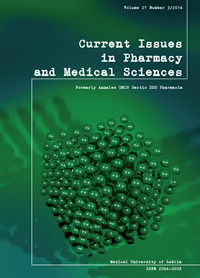The expression BIRC6 gene in patients with chronic lymphocytic leukemia – a preliminary study
DOI:
https://doi.org/10.1515/cipms-2015-0011Keywords:
apoptosis, chronic lymphocytic leukemia, BIRC6 gene, Apollon, Bruce, CLLAbstract
The BIRC6 gene encodes the Bruce (Apollon) protein. This belongs to the III class of Inhibitors of the Apoptosis Protein (IAP) and demonstrates anti-apoptotic activity (binding, inhibiting and degrading the caspases). Moreover, the Bruce protein shows multilevel activities and additional functions. The Bruce protein is involved in the maintenance of cell viability, and it is also suggested that it plays an important role in cell proliferation and diversification. Many researchers have noticed elevated BIRC6 gene expression in cell lines of brain cancer and ovarian carcinoma, leukemia, breast cancer and even in colorectal cancer tissues. Resistance to chemotherapy-inducted apoptosis in cancers characterized by BIRC6 gene over-expression was also reported. The aim of the study was to assess the BIRC6 gene expression in peripheral blood lymphocytes of patients diagnosed with chronic lymphocytic leukemia.
References
1. Abe S. et al.: Bone marrow cells of mieloblastic syndromes exhibit significant expression of apollon, livin and ILP-2 with reduction after transformation to overt leukemia. Leukaemia Research, 2005; 29: 1095-1096.
2. Bartke T. et al.:Dual role of BRUCE as an antiapoptotic IAP and a chimeric E2/E3 ubiquitin ligasz. Md Cell, 2004, 14: 801-811.
3. Bianchini M. et al.: Comparative study of gene expression by cDNA microarray in human colorectal cancer tissues and normal mucosa. Int J Oncol., 2006, 29: 83-94.
4. Bielak-Żmijewska A.: Mechanizmy oporności komórek nowotworowych na apoptozę. Problemy Nauk Biologicznych. Kosmos, 2003, 52: 157-171.
5. Chen Z. et al.: A human IAP-family gene, apollon, expressed in human brain cancer cells. Biochem Biophys Res Commun., 1999, 264: 847-854.
6. Deveraux Q.L., Reed J.C.: IAP family proteins suppressor of apoptosis. Genes Dev., 1999, 13: 239-252.
7. Ghavami S. et al.: Apoptosis and cancer: mutations within caspase. J Med Genet, 2009, 46: 497-510.
8. Giannopoulos K.: Biologia i rokowanie w przewlekłej białaczce limfocytowej. Acta Haematologica Polonica, 2010, 3: 433-440.
9. Grzybowska-Izydorczyk O., Smolewski P.: Białka inhibitorowe apoptozy z rodziny inhibitorów apoptozy (IAP) i ich antagoniści: rola biologiczna oraz potencjalne znaczenie w karcinogenezie i celowanej terapii przeciwnowotworowej. Acta Haematologica Polonica, 2009, 40: 593-612.
10. Grzybowska-Izydorczyk O., Smolewski P.: Rola białek z rodziny inhibitora apoptozy (IAP) w chorobach rozrostowych układu krwiotwórczego. Postępy Hig Med. Dosw., 2008, 62: 55-63.
11. Guo J. et al.: A preliminary study on the implication of Apaf-1 promoter methylation and the expression of apoptosis inhibitor protein Apollon in adult acute leukaemia. Zhonghua Xue Ye Xue Za Zhi., 2010, 31: 736-739.
12. Ismail EA. Et al.: BIRC6/Apollon gene expression in childhood acute leukemia: impact on therapeutic response and prognosis. Eur J Haematol. 2012, 88:118-27. [53]
13. Kaczmarek-Borowska B., Zmorzyński Sz., Filip A.: Biologiczna rola surwiwiny. Współczesna onkologia 2008, 10: 437-440.
14. Korzeniowska-Dyl I.: Kaspazy – struktura i funkcja. Pol. Merk. Lek. 2007, 138: 403-407.
15. Krawczyk-Kuliś M et al.: Nowe markery prognostyczne przewlekłej białaczki limfocytowej badane metodą immunofenotypizacji. Acta Haematologica Polonica, 2012, 3: 271-276.
16. Lewandowski K, Matuszak M.: Czynniki prognostyczne w przewlekłej białaczce limfatycznej B-komórkowej. Współczesna Onkologia, 2003, 7:470–475.
17. Lopergolo A. et al.: Apollon gene silencing induces apoptosis in breast cancer cells through p53 stabilisation and caspase-3 activation. Journal List, 2009, 100: 739-746.
18. Lotz K., Pyrowolakis G., Jentsch S.: BRUCE, a gigant E2/E3 ubiquitin ligase and inhibitor of apoptosis protein of the trans – Golgi network, is required for normal placenta development and mouse survival. Mol Cell Biol., 2004, 24: 9339-9350.
19. Malinowska I.: Rola apoptozy w patogenezie i leczeniu nowotwór układu hematopoetycznego. Postępy Hig Med. Dosw., 2004, 58: 548-559.
20. Mitrus I., Missot-Kolka E., Szala S.: Geny proapoptotyczne w terapii genowej nowotworów. Współczesna onkologia, 2001, 5: 242-249.
21. Pohl C., Jentsch S.: Final stages of cytokinesis and mid-body ring formation are controlled by BRUCE. Cell, 2008, 132: 832-845.
22. Qiu X.B. et al.: Nrdpl-mediated degradation of the gigantic IAP, BRUCE, is a novel pathway for triggering apoptosis. EMBO J., 2004, 23: 800-810.
23. Rumble J.M., Duckett C.S.: Diverse function within the IAP family. Journal of Cell Science, 2008, 121: 3505-3507.
24. Rupniewska Z., Koczkodaj D., Wąsik-Szczepanek E.: BRUCE/Apollon i jego rola w rodzinie białek hamujących apoptozę. Acta Haematologica Polonica, 2006, 37: 329-337.
25. Salilew-Wondim D et al.:. Depletion of BIRC6 leads to retarded bovine early embryonic development and blastocyst formation in vitro. Reprod Fertil Dev., 2010, 22: 564-79.
26. Stańczyk M., Majsterek I.: Apoptoza – cel ukierunkowanej terapii przeciwnowotworowej. Postępy Biologii Komórki, 2008, 35: 467-484.
27. Sung K.W. et al.: Over-expression of Apollon, an antiapoptotic protein is Associated with Poor Prognosis in Childhood De novo Acute Myeloid Leukemia. Clin CANCER Res., 2007 13: 5109-5114.
28. Verhagen A.M., Coulson E.J., Vaux D.L.: Inhibitor of apoptosis proteins and their relatives: IAPs and other BIRPs. Genome Biology, 2001, 2: 3009.1-3009.10.
29. Wright C.W., Duckett C.S.: Reawakening the cellular death program in neoplasia through the therapeutic blockade of IAP. J Clin Invest, 2005, 115: 2673-2678.
30. Yamamoto K. et al.: Expression of IAP proteins in myelodysplastic syndromes trans forming to overt leukemia. Leukemia Research, 2004, 28: 1203-1211.
31. Yang L.Y., Li X.M.: The IAP family: endogenous caspase inhibitors with multiple biological activities. Cell Research, 2000, 10: 169-177.
32. Hao Y., Sekine K., Kawabata A., Nakamura H., Ishoika T., Ohata H., KatayamaR., Hashimoto C., Zhang X., Tsuro T., Kwaito M. Apollon ubiquitinates Smac and caspases-9 and has an essential cytoprotetion function. Nature Cell Biol, 2004, 6: abstract.
33. Sekine K., Hao Y., Suzuki Y., Takahashi R., Tsuruo T., Natio M. HtrA2 cleaves Apollon and induces cell death by IAP-binding motif in Apollon-deficient cells. Biochem Biophys Res Commun., 2005, 330: abstract
34. Hauser H.P., Bardoff M., Pyrowolakis G., Jentsch S. A giant ubiquitin-conjugating enzyme related to IAP apoptosis inhibitors. J Cell Biol. 1998,141: abstract.
Downloads
Published
Issue
Section
License
Copyright (c) 2015 Authors

This work is licensed under a Creative Commons Attribution-NonCommercial-NoDerivatives 3.0 Unported License.


